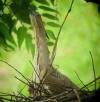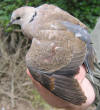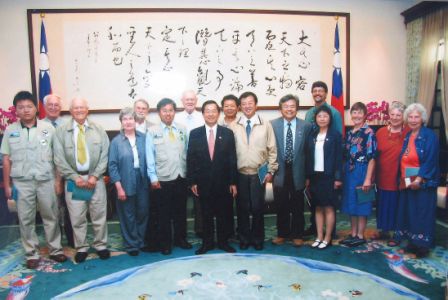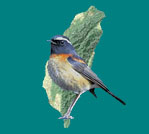|
Trip Report:%20right%20side,%20resize.jpg)
BIRDING
IN TAIWAN,
MAY
2–11, 2005,
for Fairy
Pitta
Leaders:
Simon Liao and Ten-Di Wu
(E) =
Endemic
Taiwan is a mountainous island in the
South China
Sea,
about 160 km (100 miles) off the Chinese mainland. The forested beauty of
the island led Portuguese sailors in 1590 to name it Ilha Formosa,
meaning “Beautiful
Island.” The tropic of Cancer passes through the southern part of the
island.
Monday–Tuesday, May 2–3 Day 1
Taipei
to Kukwang
Our EVA Airways flight departed Vancouver at 1:50 a.m. Pacific Daylight Time
on May 2, arriving at Chiang Kai-Shek International Airport, Taoyuan, 50 km
west of Taipei, at 5:10 a.m. on May 3. We transferred to our comfortable
bus. Taiwan’s rainy season had begun only a few days before, but our
leader, Simon Liao assured us that we would drive out of the wet conditions
as we went south, and we did. The Tung trees Aleurites Montana,
(called “May Snow” because the fallen blossoms carpet the ground like snow),
were in flower.
 Near
Taichung,
we picked up our co-leader, Ten-Di Wu, and assistants Linda Kao and “Kite”
Liu. Heading southeast into the hills toward Wufeng, we made our first
attempt to find Fairy Pitta, but although we heard a calling bird, we could
not locate it. Other species in this area were Light-vented Bulbul
(abundant), Black-browed Barbet, Plain Prinia, Brownish-flanked
Bush-Warbler, Collared Finchbill, Crested Serpent-Eagle, Crested Goshawk,
and Malayan Night-Heron (on nest). Continuing farther into the hills, in
the vicinity of Tunglin village, we found Formosan Magpie (E),
Gray-spotted Flycatcher, Gray Treepie, Gray-cheeked Fulvetta, Rufous-capped
Babbler, Gray-capped Pygmy Woodpecker, and Yellow-browed Warbler. Leaving
the village, we came across a Japanese Sparrowhawk and 2 migrant Chinese
Goshawks. Continuing on, we arrived at Kukwang on the Tachia River after
dark, and settled into the Four Seasons Resort for the night. Near
Taichung,
we picked up our co-leader, Ten-Di Wu, and assistants Linda Kao and “Kite”
Liu. Heading southeast into the hills toward Wufeng, we made our first
attempt to find Fairy Pitta, but although we heard a calling bird, we could
not locate it. Other species in this area were Light-vented Bulbul
(abundant), Black-browed Barbet, Plain Prinia, Brownish-flanked
Bush-Warbler, Collared Finchbill, Crested Serpent-Eagle, Crested Goshawk,
and Malayan Night-Heron (on nest). Continuing farther into the hills, in
the vicinity of Tunglin village, we found Formosan Magpie (E),
Gray-spotted Flycatcher, Gray Treepie, Gray-cheeked Fulvetta, Rufous-capped
Babbler, Gray-capped Pygmy Woodpecker, and Yellow-browed Warbler. Leaving
the village, we came across a Japanese Sparrowhawk and 2 migrant Chinese
Goshawks. Continuing on, we arrived at Kukwang on the Tachia River after
dark, and settled into the Four Seasons Resort for the night.
Wednesday,
May 4 Day
2 Kukwang to An Ma Shan
Early morning birding on the Shaulai Trail above the hotels produced
Collared Scops-owl, Varied Tit and more Formosan Magpies (E), but
otherwise was very quiet. We saw Plumbeous Redstarts along the Tachia
River. We moved on to the Ba Sian Shan (“Eight Fairy Mountain”) Recreation
Area, where there were more Collared Finchbills, Gray-chinned Minivets, a
Gray-capped Pygmy Woodpecker, and a Black-backed Wagtail. Continuing along
the Tachia River, we walked part of Sarlien Lane. White-bellied Yuhina,
Streak-breasted Scimitar Babblers were seen, and most of the group had good
looks at [Taiwan] Hwamei.
After lunch in Tungshih, we transferred from our bus to 3 vans for the
continuation of the drive to An Ma Shan. The road to An Ma Shan Forest
Recreation Area had been severely damaged by typhoons during the summer of
2004. Officially, the road was “closed”, but we had permission to travel on
the temporary road which provided the only access to the mountain.
Forest
workers, wardens and a small maintenance staff for the buildings still
required access, so a temporary, bridge had been constructed. Our bus was
too big to use the temporary bridge, requiring us to change to the vans. On
the way, we stopped at Km 15 and again at Km 23, the “Lookout”, where there
is a sturdy viewing platform overlooking white-flowered Idesia polycarpa
trees. On this day, there was noisy heavy equipment working at the bend of
the road. There were few birds, except for White-eared Sibia (E).
Resuming our drive, we soon saw why the bus could not make this journey.
The typhoons had caused a large part of the mountainside to break away and
plummet into the valley below, taking the road with it. For a stretch of
about 200 m, the missing road had been replaced by a temporary single-lane
bridge of wooden planks, supported by steel pylons anchored to the rock face
far below. The bridge was just wide enough for our vans to get through. We
arrived at An Ma Shan Forest Reserve, elevation 2300 m (7500 feet), in the
late afternoon. In the fading light, a party of Steere’s Liocichla (E)
foraged just below our cabins.
Thursday,
May 5 Day 3
An Ma
Shan
Forest
Reserve
Birding on Trail 210 at 5 a.m: The first bird of the morning was Gray-faced
Woodpecker, followed by Black-throated Tit, Taiwan Yuhina (E),
Red-faced Warbler, Eurasian Jay, Gray-headed Bullfinch, Gray-throated
Minivet, Green-backed Tit, Vivid Niltava, White-eared Sibia (E), Ashy
Wood-Pigeon, Vinaceous Rosefinch, and a single Silver-backed Needletail.
From the valley below, came the call of the Taiwan Partridge (E).
Historically, this has been a good place to find Mikado Pheasant, and
sometimes Swinhoe’s Pheasant, but today we were not lucky.
In mid-morning, we moved up to Trail 220 at Km 39, but shortly beyond the
trailhead, we found the way blocked by a rockfall, caused by a combination
of typhoon and earthquake. We saw White bellied Pigeon and heard
White-browed Shortwing.
Driving higher, we saw Black Eagle and Great-spotted Eagle as they flew over
the valley. Arriving at Hsaio Xai Shan (“Little Snow Mountain”), elevation
2600 m (8500 ft.), we walked part of Trail 230, seeing White-whiskered
Laughingthrush (E), Collared Bush-Robin (E), Coal Tit,
Eurasian Nutcracker and an agitated Yellow-bellied Bush-Warbler. Some of
the group ventured farther, encountering a trail wash-out and glimpsing a
Taiwan Serow, an endemic herbivore.
Friday, May
6 Day
4 An Ma Shan to Douliou
We returned to Trail 210 in the early morning, hoping for better success
with pheasants, but it was not to be. South winds were blowing strongly,
preceding a storm front. One person saw
Taiwan
Barwing (E).
As we ate our picnic breakfast near the park entrance, 4 White-throated
Laughingthrushes moved through the trees behind us. We drove the road to
Hsiao Xai Shan again, hoping for pheasants, but still were not lucky. Rain
began.
_small.JPG) We drove to the lowlands, to Lugang, in pouring rain. The rain abated
somewhat as we went to a large open field on the outskirts of the city,
which held several species, including Oriental Skylark, Zitting Cisticola,
and a briefly-glimpsed Black-capped Kingfisher.
We drove to the lowlands, to Lugang, in pouring rain. The rain abated
somewhat as we went to a large open field on the outskirts of the city,
which held several species, including Oriental Skylark, Zitting Cisticola,
and a briefly-glimpsed Black-capped Kingfisher.
We went to Hambao wetland in drizzle; the wind continued. We saw Little
Egret, Curlew, Sharp-tailed and Marsh Sandpipers, Ruddy Turnstone,
Red-necked Stint, Lesser Sandplover, and Oriental Plover, a rare vagrant in
Taiwan, in a rice paddy.
As the rain stopped, we made our way to the Choushui River to watch for
Allied Nightjar at dusk. Some birds seen in addition to the nightjars were
Cinnamon Bittern, Golden-headed Cisticola and Oriental Pratincole.
We continued to the Metro Hotel in Douliou (Touliu) for the night.
Saturday,
May 7 Day 5
Douliou to Kuang Tselin Hot Spring
We made an early start for the hot, lush, dense lowland forest of Mango
Valley. We walked a short distance along the small, quiet stream that flows
through the valley bottom. After a while, we saw a beautiful Fairy Pitta
(and heard more), as well as Rufous-capped Babbler, Collared Finchbill,
Black Bulbul and Black-naped Monarch. The sharp, double-whistle call of the
Fairy Pitta can be heard a kilometre away, but seeing the bird requires
patience.
At the Aougo (Aouwu, Aoku) Wetland, there were Little Grebe, Yellow and
Cinnamon Bitterns, many herons, egrets, Common Moorhen, Black-winged Stilt,
Pacific Golden and Black-bellied Plover; Greater and Lesser Sandplover,
Snowy Plover, Common Greenshank; Marsh, Green, Terek and Common Sandpipers, and Red-necked
Stint. A White-breasted Waterhen made a very brief appearance in a
water-filled ditch. Across the road, a Red-collared Dove was found caught
an illegal net. The bird was extracted from the net, photographed and
released unharmed.
Common Greenshank; Marsh, Green, Terek and Common Sandpipers, and Red-necked
Stint. A White-breasted Waterhen made a very brief appearance in a
water-filled ditch. Across the road, a Red-collared Dove was found caught
an illegal net. The bird was extracted from the net, photographed and
released unharmed.
Farther south, in the Putai town vicinity, we discovered 9 late-lingering
Black-faced Spoonbills, along with many waders, including Spotted Redshank.
At the Pachang River Mouth, there were Eurasian Curlew, Terek Sandpiper, as
well as Little, Whiskered and Black-naped Terns.
We turned west into the hills, arriving at Kuang Tselin (Kuantzuling) hot
Springs after dark. A Mountain Scops-Owl called near our hotel, and was
seen by some of the group.
Sunday, May
8 Day
6 Kuang Tselin to Kenting
After our early outdoor breakfast, we watched a Formosan Whistling-Thrush
(E) carry food to a concealed nest in the eaves of the house cross the
road. Then we headed to the Tsengwen Dam area. The best birds there were
Chinese Bamboo Partridge and Dollarbird (rare).
Next, we went to the Kwangtien (Guantian) Wetland where we saw 3
Pheasant-tailed Jacanas resplendent in breeding plumage. Simon and Ten-Di
received a tip that 2 Chinese Egrets had been found at Chiku the previous
day, so we headed back to the coast to look for them. After some searching,
we were successful in relocating one.
We turned south once more and headed for Kenting (Kending) in Taiwan’s
tropical far south. Before going to our hotel, we stopped at
Long
Luan Tan Lake at dusk, finding Chinese Pond Heron and Bar-tailed Godwit as
another storm approached. Thunder, lightening and more rain arrived during
supper. We checked in at the Seaview Resort.
Monday, May
9 Day
7 Kenting to A Li Shan
Styan’s Bulbul (E) is found only in the extreme south and east of
Taiwan. In appropriate habitat, this endemic bulbul is easy to find. Like
the very common Light-vented Bulbul, Styan’s can be found in Kenting city,
and in the countryside.
We went out at 5 a.m., returning to Long Luan Tan Lake. We had better
success than in the previous evening, finding
_small.JPG) Chinese
Pond Heron, Ruddy-breasted Crake and White-breasted Waterhen. We returned
to the Seaview Resort for breakfast, then departed northward, to Inda
EcoFarm, the only place in
Taiwan
where Black-naped Oriole can still be reliably found. We saw 4 of these
orioles, including a female on a nest. As we had still not found Maroon
Oriole, we spent some time in the Chung Pu town area, searching. At last,
success! Chinese
Pond Heron, Ruddy-breasted Crake and White-breasted Waterhen. We returned
to the Seaview Resort for breakfast, then departed northward, to Inda
EcoFarm, the only place in
Taiwan
where Black-naped Oriole can still be reliably found. We saw 4 of these
orioles, including a female on a nest. As we had still not found Maroon
Oriole, we spent some time in the Chung Pu town area, searching. At last,
success!
We began to climb toward A Li Shan, arriving at A Li Shan Forest Recreation
Area, the Ying Shan Hotel in A Li Shan village, after dark. We looked
forward to having the next day in “high mountain” habitat again.
Unfortunately, heavy rain and wind began again, and continued all night.
Tuesday,
May 10 Day
8 A Li Shan to Shihmen Dam
In the morning, rain was still pouring, and our driver, Mr. Shih, was
worried about the possibility of rockfalls on the road trapping us (or
worse) on the mountain. He advised us to leave, quickly, and we agreed that
it would be prudent to do so. We started down, having to stop twice to roll
rocks off of the road.
We had better luck in lowland rice field habitat at Dar Hsi Choi (“Big
Stream Little House”) near Chiayi, finding Greater Painted-Snipe, Yellow
Wagtail and a Red-billed Starling, in the rain.
We continued north to the Shihmen Reservoir area, in the foothills of
Taoyuan County. Continuing rain and fog precluded further birding for the
day. Night at the Howard
Lake
Resort.
Wednesday,
May 11 Day
9 Shihmen Dam to
Taipei
We headed for
Taipei
for a very special event; an hour’s meeting with Taiwan’s President Mr. Chen
Shui-bien in the President’s Office, regarding birding eco-tourism and
conservation issues in Taiwan. At the conclusion of the meeting, he showed
us the Heritage Room, decorated with many aboriginal motifs, adjacent to the
reception room.
After lunch, and some shopping at the extensive Chinese Handicraft Mart, we
had an opportunity to see a little of Taipei. We visited the Hsing Tien
Temple, a Taoist temple dedicated to Kwan Yu, the male counterpart of Kwan
Yin, the Goddess of Mercy.
After supper, it was time to return to Chang Kai-Shek International Airport
for the return flight to
Vancouver.
- - - - - -
- - - - - - - - - - - - - - - - - - -
We saw 9 of 15 endemic species and heard another (Taiwan Partridge).
The total bird species for the trip was 162; 158 seen, 3 heard only,
and 1 seen by a leader only.
For more
information, contact:
Simon Liao,
simonliao0624@yahoo.com.tw, Taiwan, or
Jo Ann
MacKenzie,
j.a.mackenzie@telus.net, Canada
International Taiwan Birding Association,
www.birdingintaiwan.com

President Chen
Shui-bien (center), Heritage Room, the President’s Office, Taipei,
May 11, 2005.
Photo provided
by Public Affairs, Office of the President.
|

